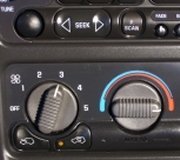You have that right about the resistor. Position "4" totally bypasses it, so if the thermal fuse in resistor assembly was bad, "4" would be the only speed that worked.
Next, positions "1" through "4" all turn on the fan relay, so if the fan runs on any speed, the relay is okay.
The only thing that can cause this is the switch assembly itself. This is especially common when the higher speeds are used often. Fan motors draw lots of current. That's why they use a relay to carry that heavy load, but that just supplies the twelve volts to the motor. They still use the sad little switch for the ground side, and it has to handle just as much current as the relay. With age and a little arcing, resistance builds up between the contacts, and that results in heat. The heat causes more resistance to build up, then more heat, and on and on until the contacts become too degraded to carry that much current.
The common switch contact is just as burned up as the number "4" contact, but it will still work for a while on the other settings. Eventually contacts "3", then "2" will also burn up.
The repair is to replace the switch assembly, but you must also replace the terminals in the connector. Those are going to be black or discolored too, and the connector body is likely to be melted. Those terminals also have resistance between them and the mating terminals on the switch. That resistance will cause heat, and a repeat failure if everything isn't replaced at the same time.
Check at your local auto parts store for a replacement connector to go with the new switch. They have catalogs that list a real lot connectors for engine sensors and other applications. Due to the high current and the chance of similar failures on other cars, this is one time when I would not recommend snipping a connector from a car in a salvage yard.
When the switch or connector terminals have gotten hot enough to discolor them, you are also going to find the wires are hard for about the first four inches. Solder will not adhere to that part of the car's wires. Cut off that four inches, then splice the wires to the new plug. They normally come with five or six inches of new wire. Strip about 3/8" insulation from the ends, then slide the strands into each other to make the splice. Poke down any sharp points that are sticking up. Solder the splices, check again for sharp points, then seal them with heat-shrink tubing. Never use electrical tape in a car. It will unravel into a gooey mess on a hot day.
SPONSORED LINKS
Thursday, May 17th, 2018 AT 2:01 PM



